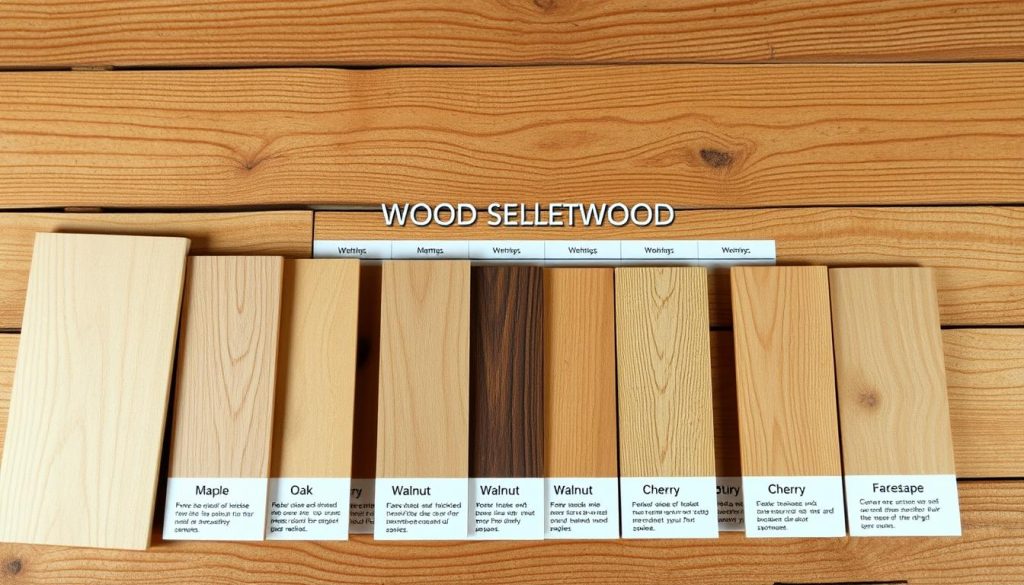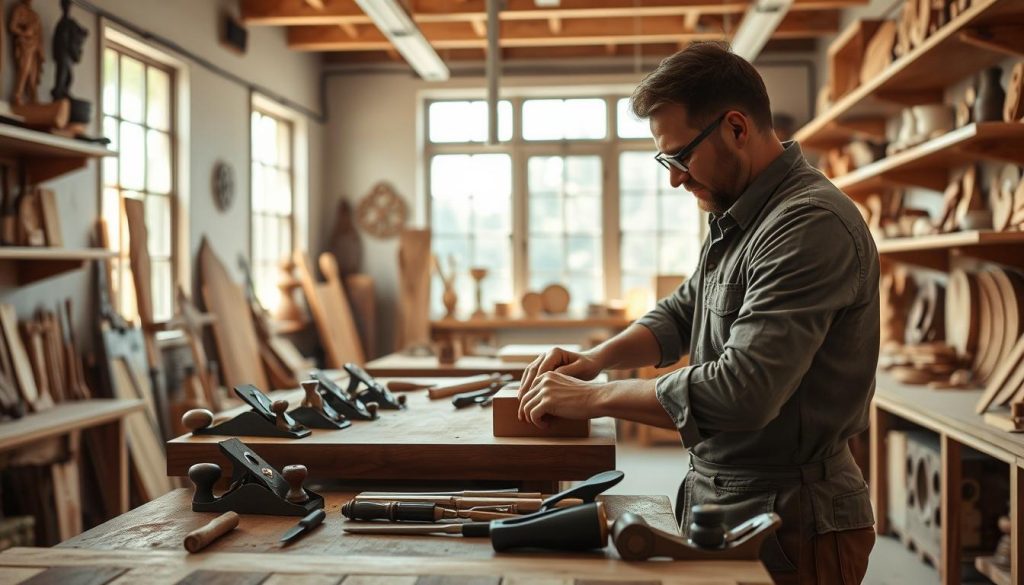Creating beautiful pieces with your own hands is incredibly exciting. Woodworking plans open a world of creativity for DIY fans at every skill level. With Kreg Tool’s vast collection, you can turn simple wood into stunning furniture and decorative items.
Whether you’re new to woodworking or have lots of experience, finding the right plans is key. DIY woodworking projects let you build everything from raised garden beds to kitchen islands. This way, you can make your living space unique with handmade items.
Key Takeaways
- Woodworking plans provide a roadmap for creating custom projects
- DIY woodworking projects suit all skill levels
- Kreg Tool offers free plans for various project types
- Handmade woodwork adds personal touch to home decor
- Woodworking is a rewarding and creative hobby
The Basics of Woodworking Plans
Woodworking plans are like blueprints for DIY projects. They help both new and seasoned woodworkers make amazing things. These plans turn complex ideas into doable projects for everyone.
Free woodworking plans are a great way for makers to get creative. They break down big projects into easy steps. This helps woodworkers know what to do before they start.
Understanding Woodworking Plans
A good woodworking plan has a few key parts:
- Detailed lists of materials needed
- Exact measurements for cuts
- Step-by-step guides
- Tools you’ll need
- Diagrams and pictures for help
Key Benefits of Using Woodworking Plans
Woodworking plans are great for both pros and hobbyists. They offer:
- More accurate projects
- Less waste of materials
- Clear steps for hard projects
- More confidence in new projects
- Learning new skills
Looking for free plans online or in magazines? These resources are key to making beautiful, useful items. They show off your skills.
Types of Woodworking Projects
Woodworking is full of possibilities for all skill levels. Whether you’re new or looking to grow, knowing the different types helps you pick the right project.
Woodworking blueprints guide you in making beautiful, useful items. Let’s dive into the exciting world of woodworking projects. They can turn your hobby into a fulfilling craft.
Furniture Projects
Furniture making is a great starting point for woodworkers. Beginners can start with simple projects like:
- Side tables with clean, straightforward designs
- Children’s bookcases that grow with their imagination
- Counter-height stools for kitchen spaces
- Rustic coffee tables perfect for living rooms
Decorative Items
Smaller projects help improve precision and technique. Decorative items let woodworkers try new things while making unique pieces:
- Elegant picture frames
- Personalized wooden signs
- Intricately carved wooden bowls
- Customized wall hangings
Outdoor Structures
Woodworking can also change outdoor spaces. Beginner woodworking plans include engaging structures like:
- Garden pergolas
- Comfortable wooden benches
- Practical deck planters
- Raised garden bed frameworks
Every project type brings its own challenges and chances to grow your skills. This makes the journey fun and rewarding.
Essential Tools for Woodworking
Having the right tools is key to success in woodworking. Whether you’re making custom plans or trying new designs, the right tools matter a lot. They can improve your project’s quality and how fast you finish it.
Starting woodworking means knowing which tools are must-haves. The right tools can turn a tough project into a fun one.
Hand Tools Every Woodworker Needs
- Chisels: Critical for detailed work and precise cutting
- Hand planes: Essential for smoothing and shaping wood surfaces
- Measuring tape and combination square: Ensure accuracy in custom woodworking plans
- Marking gauge: Perfect for creating consistent measurements
- Claw hammer: Basic but fundamental for joining wood pieces
Power Tools for Precision and Efficiency
- Drill: Versatile tool for creating holes and driving screws
- Kreg pocket hole jig: Helps create strong, hidden joints in woodworking design plans
- Miter saw: Enables precise angle cuts for complex projects
- Random orbital sander: Provides smooth finishing touches
- Table saw: Crucial for making straight and consistent cuts
Getting tools is a step-by-step process. Begin with the basics and add more as you get better and take on harder projects. Good tools are worth the investment. They help you make professional-looking pieces with confidence.
How to Choose the Right Wood
Choosing the right wood is key for great DIY woodworking projects. The right wood can make your woodworking plans stand out. It affects how your project looks, lasts, and feels.

When starting woodworking plans, knowing different wood types is crucial. Each wood type has its own special qualities that can make your DIY projects better.
Common Wood Types for Woodworking
- Pine: Soft, lightweight, and budget-friendly – perfect for beginners
- Oak: Durable, strong, with beautiful grain patterns ideal for furniture
- Maple: Hard, dense wood with smooth finish great for cutting boards
- Walnut: Rich dark color, excellent for high-end woodworking projects
Key Considerations When Selecting Wood
Choosing wood is more than just picking a pretty color. Think about these important things:
- How hard and durable the wood needs to be for your project
- The grain pattern and color that fits your design
- The cost and how easy it is to find the wood
- How eco-friendly the wood source is
Experts say always pick wood that matches your woodworking plans. Knowing about wood helps make your DIY projects look pro and last long.
Understanding Woodworking Measurements
Precision is key in woodworking. It’s vital when you’re using downloadable plans or coming up with new ideas. Accurate measurements help make your projects both beautiful and useful.
Learning to measure well can take your woodworking to the next level. The right way to measure ensures your projects fit together perfectly. They will look just as you dreamed.
Importance of Accurate Measurements
Accurate measurements are the base of any good woodworking project. If you don’t measure right, you might face:
- Ill-fitting joints
- Uneven surfaces
- Structural weaknesses
- Wasted materials
Tips for Measuring and Marking Wood
Professional woodworkers use a few key strategies for accurate measurements:
- Use a quality layout square for 90-degree angles
- Always measure twice before cutting
- Account for saw blade thickness
- Mark measurements clearly with a sharp pencil
- Check calibration of measuring tools regularly
When using downloadable woodworking plans, focus on the measurements given. Knowing how to read and understand these measurements will help you confidently bring your project ideas to life.
Step-by-Step Guide to Reading Woodworking Plans
Starting with woodworking blueprints can be tough for beginners. Learning to read free woodworking plans is key to finishing your projects well. Whether it’s a complex piece of furniture or a simple decoration, getting good at reading blueprints will improve your skills.
- Materials list
- Detailed cut specifications
- Assembly diagrams
- Tool requirements
Breaking Down Complex Plans
Experts say to tackle woodworking blueprints step by step. First, look over the whole plan before starting. Make sure you know what each part is, its size, and what tools you need.
- Read the entire plan thoroughly
- Check material and tool availability
- Understand each step’s sequence
- Prepare your workspace
Following Instructions Effectively
When using free woodworking plans, pay close attention to every detail. Make a checklist to keep track of your steps. If something is unclear, look for more help or talk to experienced woodworkers online.
Remember, being patient and well-prepared is crucial. It helps turn woodworking blueprints into stunning, useful pieces.
Tips for Beginners in Woodworking
Woodworking might seem scary at first, but it’s not. With the right steps, anyone can get good at it. Start by learning the basics and picking projects that make you feel confident.
Starting Simple: Ideal First Projects
When you’re new to woodworking, choose projects that fit your skill level. Good first projects are:
- Wooden bookends
- Basic picture frames
- Small decorative boxes
- Simple wall shelves
Common Mistakes to Avoid
New woodworkers often make mistakes that slow them down. Knowing these mistakes helps you improve faster.
- Rushing through woodworking plans without careful preparation
- Neglecting safety equipment and precautions
- Attempting overly complex projects too quickly
- Skipping proper wood measurement and preparation
Being patient and practicing is crucial. Start with easy projects, learn new techniques, and then try harder ones.
Enhancing Your Woodworking Skills
Getting better at woodworking means always learning and talking with other craftsmen. Woodworking plans are more than just blueprints. They help you grow your skills and connect with others.

Digital tools have changed how we learn and share woodworking. Many online resources help both new and seasoned woodworkers improve their plans.
Online Woodworking Communities
- Professional forums dedicated to woodworking techniques
- YouTube channels with detailed project tutorials
- Social media groups for sharing woodworking projects
- Specialized websites featuring expert advice
Local Learning Opportunities
Learning by doing is key for woodworking skills. Local classes and workshops let you work with experts. They help you grasp complex plans and techniques.
- Community college woodworking courses
- Local craft center workshops
- Woodworking clubs and meetups
- Maker spaces with woodworking equipment
By using online resources and local classes, woodworkers can keep improving. They can make more detailed plans and join a community of makers.
Safety Tips for Woodworking
Woodworking is a fun journey into making things with wood. But, safety always comes first. When you work on DIY projects, you need to watch out for risks in your workshop. Knowing and using the right safety steps will let you enjoy your woodworking without worrying about your health.
Essential Safety Gear
Wearing the right gear is the first step to safety. Here are the must-haves for every woodworker:
- Safety glasses or goggles to protect your eyes from flying particles
- Hearing protection like earplugs or headphones to block loud noises
- Dust masks or respirators to keep wood dust out of your lungs
- Close-fitting work gloves to protect your hands
- Steel-toed boots to prevent injuries from falling objects
Safe Practices in the Workshop
Creating a safe space is more than just wearing gear. Here are key safety tips for woodworking:
- Keep your workspace tidy and organized
- Make sure your tools are sharp and check your equipment often
- Don’t use power tools when you’re tired or not focused
- Use push sticks and guards on table saws
- Make sure there’s good air flow to cut down on dust
Remember, safety is not optional in DIY woodworking. By following these tips, you’ll stay safe and make beautiful woodwork with confidence.
Showcasing Your Completed Projects
Bringing your woodworking project to life is an exciting journey. It doesn’t end when you put down your tools. The final stage is finishing and presenting your work to the world. Whether it’s furniture, decorative items, or unique wooden pieces, showing off your skills is rewarding.
Exploring various finishing techniques can transform your project. Stains, protective coatings, and paint can highlight the wood’s natural beauty. They also provide essential protection. Woodworkers suggest choosing finishes that match the wood’s grain and the project’s use.
Capturing Your Craftsmanship
Photographing your projects is key for sharing with the woodworking community. Use natural lighting and clean backgrounds to show off details. Platforms like Instagram, Pinterest, and woodworking forums are great for sharing plans and inspiring others.
Connecting with Fellow Woodworkers
Local woodworking clubs and online communities are great for showing your work. You’ll get feedback and join a network of passionate woodworkers. They appreciate the art of crafting with wood.